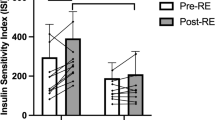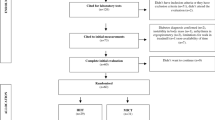Abstract
The aim of this study was to examine the independent effect of high lean mass on glucose metabolism, as well as its consequences on the classic relationship between BMI and insulin sensitivity (SI) in 3 groups: 1) 8 strength-trained males with BMI >27 kg/m2 (athletes); 2) 10 sedentary males with BMI >27 kg/m2 (obese); and 3) 12 sedentary males with BMI 22–25 kg/m2 (control). Body composition was measured with impedance analysis. Iv glucose tolerance test was performed at 09:00 h after overnight fast. Estimation of insulin sensitivity and glucose effectiveness by Minimal Model Approach. Plasma glucose and insulin determination by glucose-oxidase and RIA respectively. BMI and lean mass (LM) were greater in athletes than in controls, but there were no differences in fat mass (FM), basal glucose (Gb), basal insulin (Ib), glucose tolerance (Kg), SI, glucose effectiveness (Sg), acute insulin response to glucose (AIRG) and leptin. Obese showed greater FM, leptin, Ib and AIRG than athletes, while SI was lower; BMI, LM, Gb, Kg and Sg were similar. BMI, FM, LM, Ib, AIRG and leptin were lower in controls than in obese, while SI index was greater; Gb, Sg and Kg were similar. We found that: 1) Resistance exercise does not modify glucose effectiveness, but can improve insulin sensitivity through FM reduction (LM augmentation alone has no effect on glucose metabolism); and 2) High BMI causes insulin resistance only if it depends on adipose tissue hypertrophy.
Similar content being viewed by others
References
Conard V., Franckson J. Influence de l’effort musculaire sur l’assimilation glucidique chez l’homme normal. C. R. Seances Soc. Biol. Fil. 1957, 51: 2228–2230.
DeFronzo R., Tobin J., Andres R. Glucose clamp technique: a method for quantifying insulin secretion and resistance. Am. J. Physiol. 1979, 237: 214–223.
Bergman R., Ziya-Ider Y., Bowden C., Cobelli C. Quantitative estimation of insulin sensitivity. Am. J. Physiol. 1979, 236: 667–677.
Kahn S., Larson V., Beard J., et al. Effect of exercise on insulin action, glucose tolerance and insulin secretion in aging. Am. J. Physiol. 1990, 258: 937–943.
Brun J., Guitrand-Hugret R., Boegner C., Bouix O., Orsetti A. Influence of short-term submaximal exercise on parameters of glucose assimilation analyzed with the minimal model. Metabolism 1995, 44: 833–840.
Higaki Y., Kagawa T., Fujitani J., et al. Effects of a single bout of exercise on glucose effectiveness. J. Appl. Physiol. 1996, 80: 754–759.
Araujo-Vilar D., Osifo E., Kirk M., García-Estevez D., Cabezas-Cerrato J., Hockaday T. Influence of moderate physical exercise on insulin-mediated and non-insulin-mediated glucose uptake in healthy subjects. Metabolism 1997, 46: 203–209.
Heath G., Gavin J., Hinderliter J., Hagberg J., Bloomfield S., Holloszy O. Effects of exercise and lack of exercise on glucose tolerance and insulin sensitivity. J. Appl. Physiol. 1983, 55: 512–517.
Mikines K., Sonne B., Tronier B., Galbo H. Effects of acute exercise and detraining on insulin action in trained men. J. Appl. Physiol. 1989, 66: 704–711.
Tokuyama K., Higaki Y., Fujitani J., et al. Intravenous glucose tolerance test-derived glucose effectiveness in physically trained humans. Am. J. Physiol. 1993, 265: 298–303.
Prigeon R., Kahn S., Porte D. Changes in insulin sensitivity, glucose effectiveness, and β-cell function in regularly exercising subjects. Metabolism 1995, 44: 1259–1263.
Yarashesky K., Campbell J., Smith K., Rennie M., Holloszy J., Bier D. Effect of growth hormone and resistance exercise on muscle growth in young men. Am. J. Physiol. 1992, 262: 261–267.
Treuth M., Ryan A., Pratley R., et al. Effects of strength training on total and regional body composition in older men. J. Appl. Physiol. 1994, 77: 614–620.
Campbell W., Crim M., Young V., Evans W. Increased energy requirements and changes in body composition in older adults. Am. J. Clin. Nutr. 1994, 60: 167–175.
Yki-Järvinen H., Koivisto V. Effects of body composition on insulin sensitivity. Diabetes 1983, 32: 965–969.
Miller J., Pratley R., Goldberg A. et al. Strength training increases insulin action in healthy 50 to 65 year old men. J. Appl. Physiol. 1994, 77: 1122–1127.
Zachwieja J., Toffolo G., Cobelli C., Bier D., Yarasheski K. Resistance exercise and growth hormone administration in older men: Effects on insulin sensitivity and secretion during a stable-label intravenous glucose tolerance test. Metabolism 1996, 45: 254–260.
Ishii T., Yamakita T., Sato T., Tanaka S., Fujii S. Resistance training improves insulin sensitivity in NIDDM subjects without altering maximal oxygen uptake. Diabetes Care 1998, 21: 1353–1355.
Fujitani J., Higaki Y., Kagawa T., et al. Intravenous glucose tolerance test-derived glucose effectiveness in strengthtrained humans. Metabolism 1998, 47: 874–877.
Felber J., Ferranini E., Golay A., et al. Role of lipid oxidation in pathogenesis of insulin resistance of obesity and type II diabetes. Diabetes 1987, 36: 1341–1350.
Campbell P., Gerich J. Impact of obesity on insulin action in volunteers with normal glucose tolerance. Demonstration of a threshold for the adverse effect of obesity. J. Clin. Endocrinol. Metab. 1990, 70: 1114–1118.
Pacini G., Bergman R. MINMOD: A computer program to calculate insulin sensitivity and pancreatic responsivity from the frequently sampled intravenous glucose tolerance test. Comput. Methods Programs Biomed. 1986, 23: 113–122.
Fukushima M., Nakai Y., Taniguchi A., Imura H., Nagata I., Tokuyama K. Insulin sensitivity, insulin secretion, and glucose effectiveness in anorexia nervosa: a minimal model analysis. Metabolism 1993, 42: 1164–1168.
Marchesini G., Pacini G., Bianchi G., Patrono D., Cobelli C. Glucose disposal,β-cell secretion, and hepatic insulin extraction in cirrhosis: a minimal model assessment. Gastroenterology 1990, 99: 1715–1722.
Maki K., Abraira C. Insulin sensitivity, insulin secretion, and glucose effectiveness in anorexia nervosa: a minimal model analysis. Metabolism 1994, 43: 529–530, (letter).
Sims E., Danfort E., Horton E., Bray G., Glennon J., Salans L. Endocrine and metabolic effects of experimental obesity in men. Recent Prog. Horm. Res. 1973, 29: 457–496.
Felber J., Golay A., Jequier E., et al. The metabolic consequences of long-term human obesity. Int. J. Obes. 1988, 12: 377–389.
Felber J. From obesity to diabetes; Pathophysiological considerations. Int. J. Obes. Relat. Metab. Disord. 1992, 16: 937–952.
Felber J., Haesler E., Jequier E. Metabolic origin of insulin resistance in obesity with and without type 2 (non-insulin-dependent) diabetes mellitus. Diabetologia 1993, 36: 1221–1229.
Hamilton B., Paglia D., Kwan A., Deitel M. Increased obese mRNA expression in omental fat cells from massively obese humans. Nat. Med. 1995, 1: 953–956.
Lonnqvist F., Arner P., Nordfors L., Schalling M. Overexpression of the obese (ob) gene in adipose tissue of human obese subjects. Nat. Med. 1995, 1: 950–953.
Considine R., Sinha M., Heiman M., et al. Serum immunoreactive leptin concentrations in normal-weight and obese humans. N. Engl. J. Med. 1996, 334: 292–295.
Gippini A., Mato A., Peino R., Lage M., Dieguez C., Casanueva F. Effect of resistance exercise (body building) training on serum leptin levels in young men. Implications for relationship between body mass index and serum leptin. J. Endocrinol. Invest. 1999, 22: 824–828.
Author information
Authors and Affiliations
Corresponding author
Rights and permissions
About this article
Cite this article
Gippini, A., Mato, A., Pazos, R. et al. Effect of long-term strength training on glucose metabolism. Implications for individual impact of high lean mass and high fat mass on relationship between BMI and insulin sensitivity. J Endocrinol Invest 25, 520–525 (2002). https://doi.org/10.1007/BF03345494
Accepted:
Published:
Issue Date:
DOI: https://doi.org/10.1007/BF03345494




